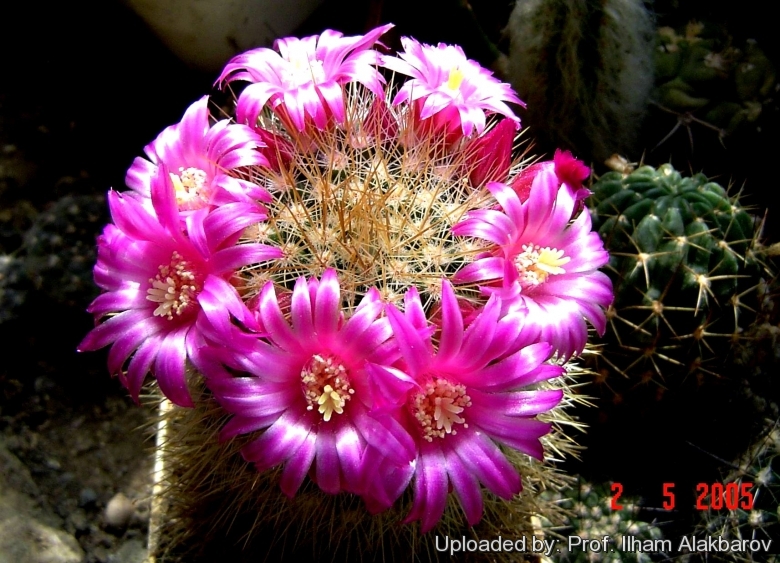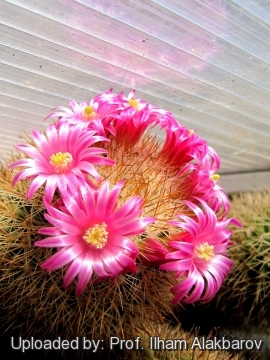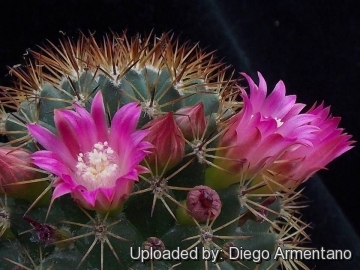
Mammillaria backebergiana Photo by: Prof. Ilham Alakbarov
Origin and Habitat: Distribution: Guerrero, Michoacan, and Mexico, Mexico.
Altitude: Around 1400-1900 metres above sea level.
Habitat and Ecology: The species grows hanging on cliffs together with Agave brevifolia and Selaginella lepidophylla. Very little is know about this species.
Synonyms:
See all synonyms of Mammillaria backebergiana
Common Names include:
UKRAINIAN (Українська): Мамілярія Бакеберга
Description: Mammillaria backebergianaSN|13783]]SN|9157]] is an attractive slender columnar cactus with yellowy or brownish-yellow spines and great purplish red flowers circling near the top of the plant during growing season. Two subspecies are recognized, the nominate and subsp. ernestii (Fittkau) Glass & R.A.Foster.
Similar species: Mammillaria backebergianaSN|9157]]SN|9157]] is related and similar to Mammillaria spinosissimaSN|9157]]SN|13783]] and its allies, but its stems are more slender.
Habit: Plants usually solitary occasionally clumping.
Stem: Globose becoming cylindrical, to 30 cm high, 5-6 cm in diameter, clear green, waxy.
Tubercles: Short pyramidal, not angled, with latex, axils naked or with a few bristles.
Central spines: 1-3, straight, needle-like, yellowish brown to brown, 7-8 mm long.
Radial spines: (8-)10-12, yellowish white with brown tips, becoming darker with age, 8-10 mm long.
Flowers: Freely produced in several rings in the crown. Purplish red, 18-20 mm long, 10-13 mm in diameter. Stigmas green.
Fruits: Dull green above, whitish below, tinting purplish red in maturity.
Seeds: Brown.
Subspecies, varieties, forms and cultivars of plants belonging to the Mammillaria backebergiana group
 Mammillaria backebergiana Buchenau: is the most widespread and has a mid green body with only 1 to 3 central spines. Distribution: Guerrero, Michoacan, and Mexico, Mexico.
Mammillaria backebergiana Buchenau: is the most widespread and has a mid green body with only 1 to 3 central spines. Distribution: Guerrero, Michoacan, and Mexico, Mexico.- Mammillaria backebergiana subs. ernestii (Fittkau) D.R.Hunt: has darker green body, a single central spine, and generally darker spines. Distribution: Tonatico, Mexico.
Bibliography: Major references and further lectures.
1) Robert T. Craig “The Mammillaria handbook: with descriptions, illustrations, and key to the species of the genus Mammillaria of the Cactaceae” E P Publishing, 1945
2) John Pilbeam “Mammillaria The Cactus File Handbook” Cirio Pub. Services, 01/Dec/1999
3) Edward Anderson “The Cactus family” Timber Press, Incorporated, 2001
4) James Cullen, Sabina G. Knees, H. Suzanne Cubey "The European Garden Flora Flowering Plants: A Manual for the Identification of Plants Cultivated in Europe, Both Out-of-Doors and Under Glass" Cambridge University Press, 11/Aug/2011
5) David R Hunt; Nigel P Taylor; Graham Charles; International Cactaceae Systematics Group. "The New Cactus Lexicon" dh books, 2006
6) Terrazas, T., Arias, S. & Arreola, H. 2013. Mammillaria backebergiana. In: IUCN 2013. "IUCN Red List of Threatened Species." Version 2013.2. <www.iucnredlist.org>. Downloaded on 07 March 2014.
7) H. W. Fittkau, “Mammillaria ernestii H.W. Fittkau, spec. nov.”, in: Cactaceas Suculentas Mexicanas. N°16, 1971, p.36.
8) Ulises Guzmán, Salvador Arias, Patricia Dávila, “Catálogo de cactáceas mexicanas” Universidad Nacional Autónoma de México, Mexico 2003, p.114.
9) Urs Eggli, Leonard E. Newton: "Etymological Dictionary of Succulent Plant Names" Birkhäuser 2004
10) FG Buchenau: “Mammillaria backebergiana spec. nov.” In: The National Cactus and Succulent Journal . 21: 47 1966
 Mammillaria backebergiana Photo by: Prof. Ilham Alakbarov
Mammillaria backebergiana Photo by: Prof. Ilham Alakbarov Mammillaria backebergiana Photo by: Diego Armentano
Mammillaria backebergiana Photo by: Diego ArmentanoCultivation and Propagation: Mammillaria backegeriana is easily grown into clumps, but it does often have an irregular pattern of offsetting. Probably the greatest problem with growing this species is that it will become a tall column with age, and tend to lean or tip over its pot.
Growing rate: It is a relatively rapid growing and easily flowering species, it doesn't present any special challenges. Most plants will offset readily, and clumps can be produced in a few years.
Watering: Water regularly in summer, but do not overwater (Rot prone), keep dry in winter
Soil: Use pot with good drainage and a very porous potting media.
Fertilization: Feed with a high potassium fertilizer in summer.
Hardiness:* It is quite frost resistant if kept dry, hardy as low as -5° C.
Exposure: Outside full sun or afternoon shade, inside needs bright light, and some direct sun.
Propagation: Division, direct sow after last frost.












